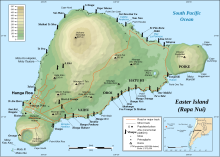Terevaka: Difference between revisions
Content deleted Content added
Srich32977 (talk | contribs) m Alter: issue. | Use this tool. Report bugs. | #UCB_Gadget | Cleaned up using AutoEd |
Volcanoguy (talk | contribs) removed Category:Pleistocene volcanoes; added Category:Pleistocene shield volcanoes using HotCat |
||
| Line 58: | Line 58: | ||
[[Category:Extinct volcanoes]] |
[[Category:Extinct volcanoes]] |
||
[[Category:Pleistocene volcanoes]] |
[[Category:Pleistocene shield volcanoes]] |
||
[[Category:Volcanic crater lakes]] |
[[Category:Volcanic crater lakes]] |
||
[[Category:Volcanoes of Easter Island]] |
[[Category:Volcanoes of Easter Island]] |
||
Revision as of 19:02, 21 June 2022
| Ma′unga Terevaka | |
|---|---|
 | |
| Highest point | |
| Elevation | 1,664 ft (507 m)[1] |
| Coordinates | 27°5′4″S 109°22′46″W / 27.08444°S 109.37944°W |
| Geography | |
| Location | Easter Island |
| Geology | |
| Mountain type | Shield volcano |
| Last eruption | Pleistocene, less than 110,000 years ago |
Ma′unga Terevaka is the largest, tallest (507.41 m (1,664.73 ft)) and youngest of three main extinct volcanoes that form Easter Island. Several smaller volcanic cones and craters dot its slopes, including a crater hosting one of the island's three lakes, Rano Aroi.


While Terevaka forms the bulk of Easter Island, the island has two older volcanic peaks: Poike which forms the eastern headland and Rano Kau the southern. Terevaka last erupted in the Pleistocene and is less than 400,000 years old. Its lava field at Roiho has been dated at between 110,000 and 150,000 years old. Terevaka can be climbed via a trail that starts next to the moai at Ahu Akivi.
Terevaka is the 12th most topographically isolated summit on Earth.[2]
See also
References
- Karsten M. Haase; Peter Stoffers; C. Dieter Garbe-Schönberg (October 1997). "The Petrogenetic Evolution of Lavas from Easter Island and Neighbouring Seamounts, Near-ridge Hotspot Volcanoes in the SE Pacific". Journal of Petrology. 38 (6): 785–813. doi:10.1093/petrology/38.6.785. Retrieved 2010-03-16.
- Kaneoka I, Katsui Y, 1985. K-Ar ages of volcanic rocks from Easter Island. Bull Volc Soc Japan, 30: 33–36.
- Vezzoli L, Acocella V, 2009. Easter Island, SE Pacific: an end-member type of hotspot volcanism. Geol Soc Amer Bull, 121: 869–886.
- ^ Maunga Terevaka, Chile at Peakbagger.com
- ^ "World Peaks with 300 km of Isolation". Peakbagger.com. Retrieved 5 March 2020.
External links
- Education-Conservation-Research Terevaka Archaeological Outreach (non-profit)
- Guide to Easter Island from the Easter Island Foundation
- Old photos of Rano Aroi (upper right)
